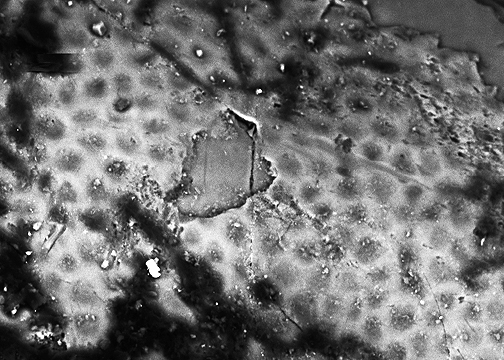Abstract
The circum-tropically distributed cryptic extant clam shrimp species Cyclestheria hislopi (Baird, 1859) is thought to be the only species of Cyclestherida, although molecular data show that its populations on different continents have large genetic distance (Schwentner et al., 2013). Its parthenogenetical reproduction and direct ovoviviparous development in the dorsal brood chamber indicate that C. hislopi is the sister taxon of all Cladocera (Olsen et al., 1996; Olsen, 1999; Olesen & Richter, 2013; Schwentner et al., 2018). While the large carapace, capable of enclosing the whole body, shows a close similarity with spinicaudatans. In this paper we document its carapace ornamentation by the use of a scanning electron microscope (SEM) and compare to related fossil taxa.
References
- Baird, W. (1859) Description of some new recent Entomostraca from Nagpur, collected by the R.S. Hislop. Proceedings of the Royal Society of London Series B-Biological Sciences, 63, 231–234.
- Chen, P.J. & Hudson, J.D. (1991) The conchostracan fauna of the Great Estuarine Group,Middle Jurassic, Scotland. Palaeontology, 34 (3), 515–545.
- Deperet, C. & Mazeran, P. (1912) Les Estheria du Permien d’Autun. Bulletin de la Société d’Histoire Naturelle d’Autun, 25, 165–174.
- Li, G. (2022) New taxonomic features of fossil clam shrimp Aquilonoglypta (Spinicaudata) and its implication for origin of triglyptids. Paleontological Research, 26 (1), 8–17. https://doi.org/10.2517/PR200028
- Liao, H.Y., Shen, Y.B. & Huang, D.Y. (2017) Conchostracans of the Middle–Late Jurassic Daohugou and Linglongta beds in NE China. Palaeoworld, 26 (2), 317–330. https://doi.org/10.1016/j.palwor.2016.11.001
- Lutkevich, E.M. (1937) O nekotorych Phyllopoda SSSR [On some Phyllopoda of the USSR]. Ezhegodnik Vsesoyuznogo Paleontologicheskogo Obshchestva, 11, 60–70. [In Russian]
- Miao, X., Chu, D.L., Tong, J.N., Benton, M.J., Yu, J.X., Luo, L., Shu, W.C. & Wu, Y.Y. (2021) Biostratigraphic significance and geometric morphometrics of Euestheria gutta (Crustacea: Branchiopoda: Spinicaudata): An index fossil of continental Permian–Triassic transitional beds. Geological Journal, 56 (12), 6176–6188. https://doi.org/10.1002/gj.4096
- Novojilov, N.I. (1946) New Phyllopoda from the Permian and Triassic deposits of the Nordwick-Khatanga region. Nedra Arctiki (Resources of Arctic), 1, 172–202. [In Russian]
- Novojilov, N.I. (1954) Upper Jurassic and Cretaceous conchostracans from Mongolia. Transactions of the Palaeontological Institute, USSR Academy of Sciences, 48, 7–124. [In Russian]
- Novojilov, N.I. (1958a) Nouveaux Conchostraca fossils. Annales du Service d’Information Géologique du Bureau de Recherches Géologiques, Géophysiques et Minières, 26, 7–14.
- Novojilov, N.I. (1958b) Conchostraca du Permien et du Trias du littoral de la Mer des Laptev et de la Toungounzka inférieure. Annales du Service d’Information Géologique du Bureau de Recherches Géologiques, Géophysiques et Minières, 26, 15–80.
- Olesen, J. (1999) Larval and post-larval development of the branchiopod clam shrimp Cyclestheria hislopi (Baird, 1859) (Crustacea, Branchiopoda, Conchostraca, Spinicaudata). Acta Zoologica, 80 (2), 163–184. https://doi.org/10.1046/j.1463-6395.1999.80220015.x
- Olesen, J. & Richter, S. (2013) Onychocaudata (Branchiopoda: Diplostraca), a new high-level taxon in branchiopod systematics. Journal of Crustacean Biology, 33 (1), 62–65. https://doi.org/10.1163/1937240X-00002121
- Olesen, J., Martin, J.W. & Roesseler, E.W. (1996) External morphology of the male of Cyclestheria hislopi (Baird, 1859) (Crustacea, Branchiopoda, Spinicaudata), with a comparison of male claspers among the Conchostraca and Cladocera and its bearing on phylogeny of the ‘bivalved‘ Branchiopoda. Zoologica Scripta, 25 (4), 291–316. https://doi.org/10.1111/j.1463-6409.1996.tb00168.x
- Raymond, P.E. (1946) The genera of fossil Conchostraca-an order of bivalved Crustacea. Bulletin of the Museum of Comparative Zoology, 96, 217–307.
- Rusconi, C. (1946) Varias especies de trilobites y esterias del Cambrico de Mendoza. Revista de la Sociedad de Historia y Geografia de Cuyo, 1, 239–246.
- Sars, G.O. (1887) On Cyclestheria hislopi (Baird), a new generic type of bivalve Phyllopoda; raised from dried Australian mud. Forhandlinger i Videnskabs-selskabet i Kristiania, 1, 223–239.
- Sars, G.O. (1900) On some Indian Phyllopoda. Archiv for Mathematik og Naturvidenskab, 22 (9): 1–30.
- Schwentner, M., Clavier, S., Fritsch, M., Olesen, J., Padhye, S., Timms, B.V. & Richter, S. (2013) Cyclestheria hislopi (Crustacea: Branchiopoda): a group of morphologically cryptic species with origins in the Cretaceous. Molecular Phylogenetics and Evolution, 66 (3), 800–810. https://doi.org/10.1016/j.ympev.2012.11.005
- Schwentner, M., Richter, S., Rogers, D.C. & Giribet, G. (2018) Tetraconatan phylogeny with special focus on Malacostraca and Branchiopoda: highlighting the strength of taxon-specific matrices in phylogenomics. Proceedings of the Royal Society B, 285, 20181524. https://doi.org/10.1098/rspb.2018.1524
- Teng, X. (2022) A morphological re-study of three spinicaudatan species from the Middle–Upper Jurassic of Gansu Province, northwestern China. Palaeoentomology, 5 (4), 327–339. https://doi.org/10.11646/palaeoentomology.5.4.5
- Teng, X. & Li, G. (2021) Morphological study of Qaidamestheria (Spinicaudata) from the Middle Jurassic in Qinghai, Northwestern China. Paleontological Research, 25 (3), 165–176, 112. https://doi.org/10.2517/2020PR019
- Wang, S.E. (1983) Some Jurassic–Cretaceous conchostracans from Qinghai. Acta Palaeontologica Sinica, 22, 460–467. [In Chinese]
- Wang, S.E. (1984) New Jurassic–Cretaceous conchostracans from northern Hebei and Nei Mongol. Acta Palaeontologica Sinica, 23 (6), 726–736. [In Chinese]
- Zhang, Y.Z., Li, G., Teng, X. Wang, L.H. & Cheng, X.S. (2017) New Jurassic spinicaudatans from Xinjiang Uygur Autonomous Region of northwestern China and their evolutionary implications. Palaeoworld, 26 (4), 663–671. https://doi.org/10.1016/j.palwor.2017.04.004


